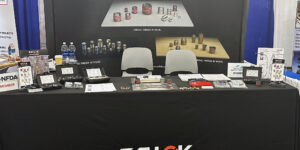DRIVE TECHNOLOGIES (Part Two): WINDING TECHNOLOGY . . . NOW DIRECTLY IN THE DRIVE
In the second part of this two-part series, Alexander Schaedlich of Siemens AG and William Gilbert of Siemens Industry explore how simply setting parameters, rather than configuring and programming, is the essential advantage of a new standard “winder” application that can be directly integrated into today’s drive systems.
Posted: October 13, 2010
Winding and unwinding wire is, at first glance, just an inconspicuous part of many industrial production processes. However, when looking at the process in greater detail, it becomes apparent that this step is extremely important in determining product quality. It is precisely for this reason that winding and unwinding must be handled with consideration given to the speed of the winder, the control processing times and also the implementation of that control scheme into the overall machine design, to achieve greater efficiency.
Electronically-controlled AC drives offer an extremely efficient means of executing the widest range of winding tasks. And today, these drives are already an integral part of most modern production equipment and systems, so the question arises: Why not use the configuring/engineering tools already available to implement winder tasks? Engineers have asked themselves precisely the same question; the answer was a standard “winder” application that has now been designed into the current generation of drives. This standard application can be used to quickly and flexibly address demanding tasks, on a new design or retrofit of a wireforming station, coiled metal or other processing line.
Implementing the winder application directly into the drive system has a basic advantage, when compared to an external controller, namely, it relieves the higher-level, open-loop control of arithmetic tasks. As a consequence, engineering resources are available for other tasks. Additionally, a control system with a lower performance and price point can be used. In any case, a high proportion of the communication load between the control system and the drive is eliminated. As a result, the associated faster response and cycle times can be more quickly and precisely realized in an open-loop control or closed-loop control, which increases the productivity and/or the winding quality, depending on the particular application.
WINDING WITH OR WITHOUT TENSION SENSORS
A winder solution generally comprises a winder drive, web and tension sensors. The task is to wind or unwind the web with a defined tension, whereby the roll diameter continually changes. The electronic drive system calculates the actual diameter using several system variables to control the motor speed and keep the tension of the material web constant. To achieve this, the velocity of the web and the winder shaft speed must be known at all times. If the highest quality tension regulation is needed, severe demands are placed on the performance and tension precision, so it makes sense to use additional sensors; for instance, dancer position control or load cells.
The standard application described here is designed for common center winders with a central shaft to drive the roll. From a control perspective, this is more challenging than a surface winder, but is the more effective of the two, as it is a much simpler version, at least from a mechanical perspective.
The standard application supports various control techniques, including open-loop torque control, direct tension control with dancer position control and speed correction, as well as tension force control with torque limiting, respectively with speed correction. This means that the standard application addresses approximately 90 percent of all winder applications found in the industry today.
The recently developed Siemens Drive Control Chart (DCC) forms the basis for the standard application (see Chart). This is a module of the graphic drive engineering tool “Starter,” found on the Sinamics S120 family. Based on the available information, drive specialists have formulated a DCC for winder applications. Using this programming language, relevant, multi-instance capable function blocks can be easily interlinked by simply dragging them from a standard library and dropping them into the chart. Users need only to parameterize the specific units such as the material velocity and acceleration, then define the closed-loop control technique. This standard application then calculates all the signals required to control the winder axis, such as speed, torque and torque limits, then integrates the specific winder functions required for the job (see Illustration 1).
The standard “winder” application allows various winding tasks to be quickly implemented, with or without tension sensors (see Illustration 2). Function blocks interlinked by dragging and dropping them (shown here for the diameter calculation) can be simply parameterized and also modified by the user for specific tasks.
DIAMETER CALCULATOR
This function is used to convert the web velocity into the corresponding motor speed. The actual diameter is obtained from the ratio of the web setpoint velocity to actual speed.
TAPER TENSION CHARACTERISTIC
This is used if the material tension should decrease as the diameter of the roll being wound increases. The taper tension characteristic is dependent on the actual diameter of the roll.
CONTROLLER ADAPTATION
Using this function, the tension controller gain can be adapted as a function of the diameter, plus the gain of the speed controller in the drive can be adapted as a function in moment of inertia on the roll being wound. This means even large build-up ratios can be easily accommodated.
ACCELERATION FEED-FORWARD
Quickly responding to velocity changes, a compensation torque can be switched to the drive while accelerating and decelerating the material. This compensation torque comprises the variable and constant moments of inertia. This prevents tension dips or excessive tension when the velocity changes. Acceleration feed-forward is usually required for open-loop tension control, but also for tension control using a load cell.
CLOSED-LOOP CONTROL TECHNIQUE: WHEN HIGH PRECISION IS A MUST
Various tension control techniques are the core of this standard winder application. Open-loop tension control is commonplace today, because sensors are not required. This mode of operation is as follows: The tension setpoint is multiplied by the actual radius of the roll being wound and the result is directly input as torque limit value. This means the motor torque linearly increases as the diameter increases and the tension is kept constant by saturating the speed controller. An important factor with open-loop control is the precise compensation of the friction and acceleration torques, so the feed-forward torque setpoint comes as close as possible to the required material tension.
OPEN-LOOP TENSION CONTROL
For tension control with dancer roll and speed correction, the web is routed over a dancer roll (see Illustration 3). The dancer roll attempts to deflect the material with a defined force. This deflection (dancer roll position) is detected using an analog sensor or encoder. The dancer roll position controller, in tandem with the drive speed controller, corrects the position actual value of the dancer roll to track the position setpoint (for example, the dancer roll center position). To do this, the position controller enters a velocity correction setpoint into the speed controller. When dancer rolls with pneumatic loading are used, dancer tension can be regulated via the taper tension characteristic feature. The dancer roll can simultaneously serve as a storage area (buffer) for the web and it also provides a damping action, for instance, on “out of round” material rolls, on layer jumps (when winding cables) or when changing rolls.
DANCER POSITION CONTROL
For the closed-loop tension control with load cell using torque limits, the material tension is directly sensed using the tension transducer and is appropriately controlled (see Illustration 4). Similar to the open-loop tension control, the speed controller in the drive operates in a saturated state, meaning that the drive is at one of the two torque limits and is controlled using these limits. The correction value from the tension controller acts on these torque limits. In addition, using setpoints from the acceleration feed-forward, the taper tension characteristic and the friction characteristic are connected to the torque limits. This taper tension function can be used to change the dancer force.
TENSION CONTROL WITH LOAD CELL
Also, for tension control with load cell and speed correction, the tension is detected using a load cell and is fed to the tension controller as actual value (see Illustration 5). However, in this case, the tension controller output acts as a velocity correction value on the speed controller. Accelerating torque, friction torque and tension force are supplied as a feed-forward.
FRICTION COMPENSATION
Friction losses can be simply compensated using a function with ten interpolation points. These are determined when commissioning the system. On a Sinamics S120 drive, for example, there is an option for automatically recording these points.
JOGGING
In the jog mode, either a path velocity setpoint can be directly entered via the interface or one of two fixed jog setpoints can be selected.
WEB BREAK DETECTION
The web break detection is active when the tension control is switched on and, depending on the control type, is configured in various ways. After a web break, the diameter computer is stopped, tension operation is disabled and the tension controller enable is withdrawn.
With the functions listed above, all the necessary resources are available to efficiently implement individual winding applications within a machine’s drive system, all in a form that is relatively simple to learn. As a result, even entry-level personnel can generate central winders for demanding solutions without knowing the actual technology in great detail. Users already experienced in handling such engineering tools can also modify the program, on which the standard application is based, as required. This allows them to customize very specific winding applications directly into the drive to suit most any commercial machine.
– – – – – – – – – – – – – – – – – – – – – – – – – – – – – – – – – – – – – – – – –
Alexander Schaedlich is an application engineer at Siemens AG, Drive Technologies, Motion Control, and William Gilbert is the industry business development manager for converting at Siemens Industry, Inc., Drive Technologies, Motion Control, 390 Kent Avenue, Elk Grove Village, IL 60007, 847-640-1595, Fax: 847-437-0784, www.usa.siemens.com/motioncontrol. For questions on this discussion, please email SiemensMTBUMarCom.sea@siemens.com.









